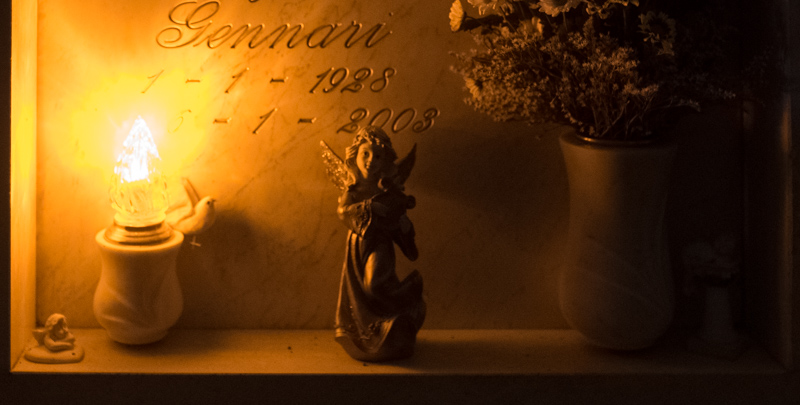
Feeling cozy in an Italian cemetery
This story started out to be about the cemetery, in honor of Halloween. As my Itch stories often do, it ended up being about something different. It is about death, but also about love and community. After all there are two holidays that follow All Hallow’s Eve: All Saints Day, and All Souls Day—days for remembering and affirming family and friendship.
One dark, rainy, winter night I decided to walk home, alone, from a nearby pizza restaurant so I could get more steps on my fitness tracker. I took the route that goes by the cemetery, and instead of walking by it, I decided to go in.
We live near this cemetery. I drive by it multiple times a day, see a steady stream of people walking by our front gate going on their daily visits, and witness funeral processions coming from the church at the top of the hill down our narrow lane to the cemetery. The hearse drives by, followed by a priest chanting on his loudspeaker, and a stream of mourners on foot. Despite this proximity, I hadn’t yet ventured inside the cemetery gates.
Italian cemeteries are special places, obviously well-visited and loved. The density of tombs is impressive, stacked five high in a sort of high-rise condo complex of mortality. It feels somehow warm, crowded, and social. I think it is due to the quirky humanity of the decorations that crowd the shelf-edge of nearly every nook. Battery-operated candles are the only lights in the graveyard at night (and there are so many that it is well lit), and one or two plastic floral arrangements in ceramic vases are crowded on every shelf, next to multiple figurines. Photos abound, which give a glimpse of the personality and passions they had in life. The gates are not locked at night, although the cemetery is officially closed, and none of the floral arrangements or figures of small angels are fixed in place.

That night I was stunned by how cozy the whole place was. At one point I realized how foreign my life here really is, that a woman alone could spend 45 minutes in a graveyard at 11:00 at night feeling cozy? Not wary and on-guard about personal safety. Not thinking of old zombie movies and ghost stories. Not even particularly melancholy about my own mortality. Somehow this kind of cemetery puts mortality in perspective and makes death seem somehow more tolerable.
In Italy, death is not hidden and sanitized. A Canadian friend of ours, who lives in the village, lost his life partner a few years ago. He found that things progress quickly here, as burial usually happens in 48-hours (bodies are not usually embalmed.) The expectation is to keep the body at home until burial, and to always keep the body company. For our friend, a steady stream of friends and neighbors came by with encouragement, food, and to help keep vigil or “veglia”.
I asked him how he thought the experience would have been different for him emotionally had his partner’s death happened in Canada, or America, where the body is immediately removed. He said although he was at first surprised, the whole experience “was like a big hug”.
He walked behind the hearse to the cemetery, accompanied by a crowd both young and old. Friends took his arm for much of the way.
He visits his partner’s grave every day to say hello, think, and remember, and also to socialize with everyone else who is visiting the cemetery. When he is away his neighbors help to tend his partner’s grave. He describes his trips to the cemetery as being like a family visit.
Italians are also pragmatic. It’s good not to become too attached to one’s nook. The place is only leased for a set number of years. After that, if the family doesn’t want to renew the lease, the bones are removed to the “ossario,” a large underground room for bones that every cemetery has, and the site in the wall reused.






No Comments